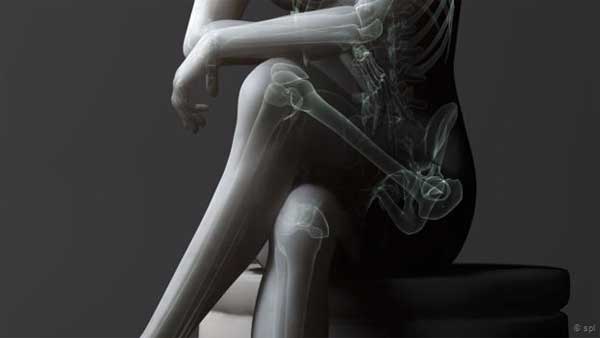Nijmegen, Netherlands (BBN)-How do you like to sit on a chair? Many people prefer to cross one leg over the other.
In the 1980s, British comedian Kenny Everett even made it his trademark – extravagantly crossing, uncrossing, then recrossing his legs while dressed in a skirt and high heels, declaring it was “all in the best possible taste”, reports BBC.
Others prefer not to cross their legs at all and even to “man spread” as it’s become known, sitting with their knees wide apart on public transport while the people either side of them are squashed.
These men might have liked a rather curious publicity campaign launched in the US in 1999 called “The Great Cross-Out” where a dietary supplement company encouraged people to keep healthy by not crossing their legs for a whole day.
But is it really any healthier to avoid crossing your legs?
The list of suggested consequences of spending too much time with one knee crossed over the other includes raised blood pressure, varicose veins and nerve damage, but each of these deserves close examination.
Of course it is true that if you spend too much time in exactly the same position, eventually your leg or your foot can go numb.
This is because crossing the legs can put pressure on the peroneal nerve behind the knee, which supplies sensation to the lower legs and feet.
But if you do give yourself pins and needles this way, it is only temporary.
Maintaining a particular posture for many, many hours can however lead to a condition called peroneal nerve palsy resulting in “foot drop” where you can’t lift the front part of your foot and toes.
But when a study from South Korea examined a series of patients’ notes in order to identify the chief causes, sitting on a chair with one knee over the other didn’t feature.
Sitting cross-legged on the floor for hours at a time did.
In reality long term numbness is an unlikely consequence of leg-crossing because as soon as we feel uncomfortable we tend to move.
So how about blood pressure?
When you get it checked, the doctor or nurse tends to ask you to rest your arm on the chair or table and to uncross your legs, putting your feet flat on the floor.
The fear is that crossed legs might skew the reading by temporarily raising your blood pressure.
By 2010, seven studies had indeed found that leg crossing does result in a higher blood pressure reading, while another study found it made no difference.
However, many of these studies were small and relied on taking a blood pressure reading just once.
One of the larger studies was conducted at a hypertension clinic in Istanbul.
Researchers there took several readings with legs crossed and uncrossed.
Again, blood pressure was higher when legs were crossed, but crucially when the measurements were repeated just three minutes after uncrossing the legs, blood pressure was back to the earlier levels.
The greatest rise in blood pressure occurs in people already being treated for high blood pressure.
Two possible mechanisms have been proposed to explain why leg-crossing might lead to a temporary rise in blood pressure.
One is that the action of putting one knee over the other sends blood from the legs up to the chest resulting in an increased quantity of blood being pumped out of the heart, raising blood pressure.
An alternative explanation is that blood pressure rises because isometric exercise of the leg muscles (exercise without the joints moving) increases the resistance to the blood passing through the vessels.
This might explain why crossing legs at the ankles doesn’t have the same effect.
In order to establish which of these explanations was the most likely, a study in Nijmegen in the Netherlands took a number of physiological measurements.
The team found that resistance in the blood vessels didn’t rise when the heart rate was low and the legs were crossed, but the amount of blood leaving the heart did, suggesting that the increased blood pressure is due to crossed legs pushing blood up to the heart.
So crossing the legs does appear to cause a temporary rise in blood pressure, but the evidence for any long-term consequences simply isn’t there, with one exception.
People at high risk of blood clots are advised not to cross their legs for long periods of time because for them, impeding the flow of blood could increase their risk of a deep vein thrombosis.
But even if crossing your legs doesn’t give you high blood pressure in the long term, what about the idea that it can give you varicose veins?
The reasons why some people suffer from varicose veins and others don’t is something of a mystery.
Usually tiny valves in the blood vessels prevent blood from flowing back in the wrong direction, but if those valves become stretched and weakened the blood can pool, resulting in the enlarged veins we call varicose veins.
Crossing the legs has not been demonstrated to be a crucial factor.
Whether or not you get varicose veins seems, partly at least, to be down to genetics.
So if veins, blood pressure and nerves are not affected by leg-crossing in the long-term, how about the impact on our joints?
One study found that people who sat with their legs crossed for more than three hours a day were more likely to lean forward and to round their shoulders.
But the research relied on people’s own estimations of how long they crossed their legs for.
As I write this, I’m sitting at my desk and happen to have my legs crossed, but I would have no idea how many hours a day I spend sitting in this way.
More recent research published this year found that if people were instructed to sit up straight while they crossed their legs the postural problems were overcome.
Of course whether that’s maintained when you have no experimenter standing over you is another matter.
Incidentally almost twice as many people reported crossing their right leg over their left knee than the other way around.
Slouching doesn’t sound good, but if you are fan of leg-crossing, you might like a rather curious study from the University Medical Centre in Rotterdam which found that it could bring benefits.
Researchers examined young men and women as they sat with their legs either straight, crossed at the knee or crossed at both the knee and the ankle at once.
They then simulated the exact angles of the posture in four embalmed pelvises, which allowed them to measure exactly what our muscles do when we cross our legs.
They found that crossing the legs at the knee increased elongation in the piriformis muscle running behind the hip joint by 11 per cent when compared with sitting with legs uncrossed, and by 21 per cent when compared with standing (interestingly the tension was slightly less if the legs were crossed at the ankle too).
The authors believe that this increases stability in their pelvic joints in a similar way to tensing the abdominal muscles does.
So if you like crossing your legs Kenny Everett-style then you’re unlikely to do yourself any damage, provided you don’t stay in the same position until your legs are numb.
And whoever is sitting next to you on the bus or the train will be grateful to you for taking up less room than the man-spreaders.
BBN/SK/AD

No Subscription? You Are Missing Out!
Join the business leaders of Bangladesh who rely on BBN's original reporting and in-depth analysis on business scenario of the country. We send only one daily email. No Spam Guaranteed!









